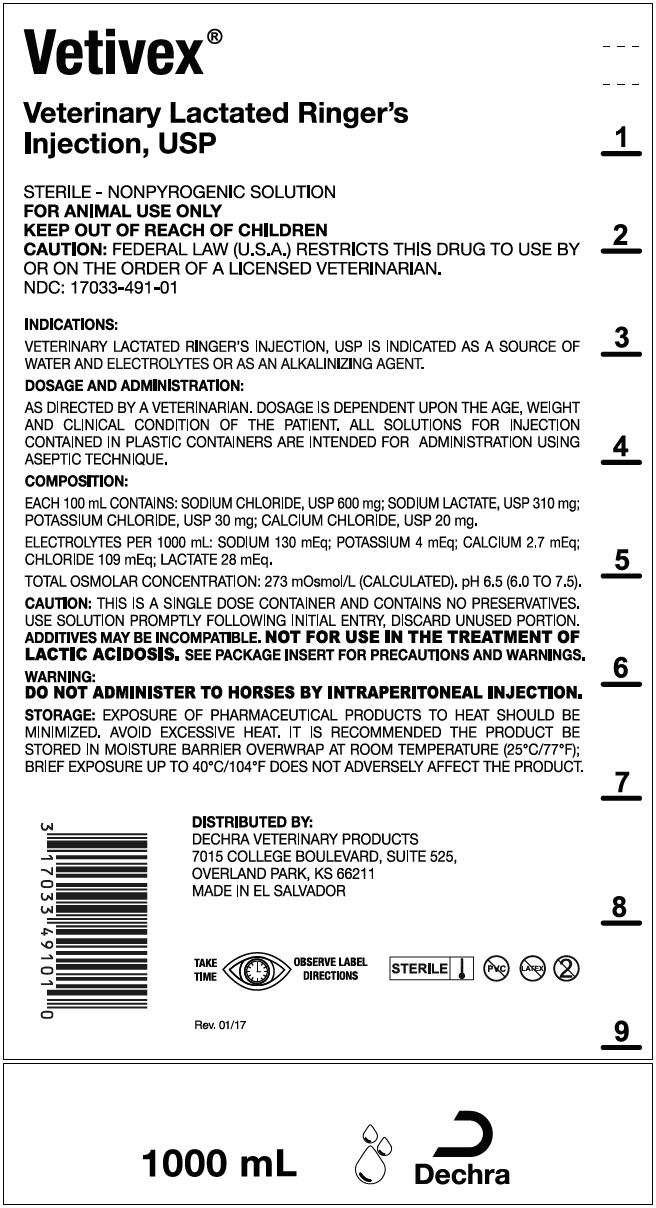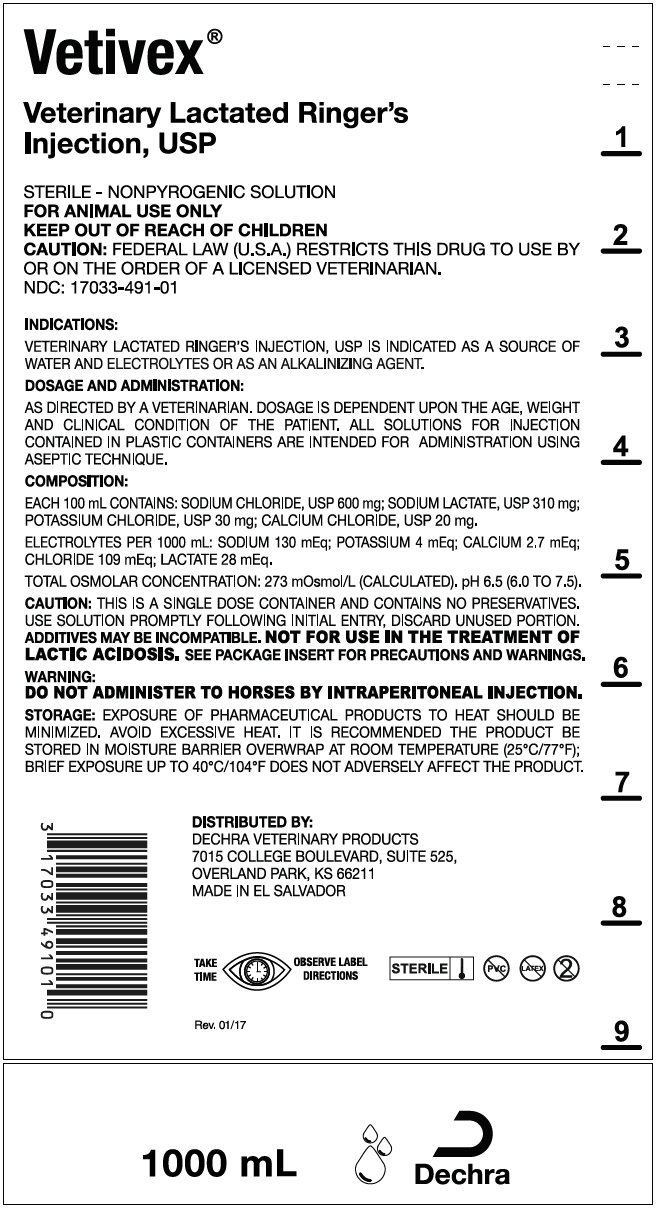Label: VETIVEX VETERINARY LACTATED RINGERS- sodium lactate, sodium chloride, potassium chloride, and calcium chloride injection, solution
-
NDC Code(s):
17033-491-01,
17033-491-03,
17033-491-05,
17033-491-25, view more17033-491-50
- Packager: Dechra Veterinary Products
- Category: PRESCRIPTION ANIMAL DRUG LABEL
- DEA Schedule: None
- Marketing Status: unapproved drug other
DISCLAIMER: This drug has not been found by FDA to be safe and effective, and this labeling has not been approved by FDA. For further information about unapproved drugs, click here.
Drug Label Information
Updated December 1, 2021
If you are a consumer or patient please visit this version.
- Download DRUG LABEL INFO: PDF XML
- Official Label (Printer Friendly)
- SPL UNCLASSIFIED SECTION
-
Description:
Veterinary Lactated Ringer's Injection, USP is a sterile, nonpyrogenic solution for fluid and electrolyte replenishment in single dose containers for parenteral administration. It contains no antimicrobial agents.
Table 1 Veterinary Lactated Ringer's Injection, USP Composition (mg/100mL) Ionic Concentration (mEq/L) kcal/L Size (mL) Sodium Chloride, USP
(NaCl)Sodium Lactate, USP
(C3H5NaO3)Potassium Chloride, USP
(KCl)Calcium Chloride, USP
(CaCl2∙ 2H2O)Osmolarity (mOsmol/L)
(Calculated)pH Sodium Potassium Calcium Chloride Lactate Caloric Content 250 600 310 30 20 273 6.5
(6.0 to 7.5)130 4 2.7 109 28 9 500 1000 3000 5000 -
Clinical Pharmacology:
Veterinary Lactated Ringer's Injection, USP has value as a source of water and electrolytes. It is capable of inducing diuresis depending on the clinical condition of the patient.
Veterinary Lactated Ringer's Injection, USP produces a metabolic alkalinizing effect. Lactate ions are metabolized ultimately to carbon dioxide and water, which requires the consumption of hydrogen cations.
- Indications and Usage:
-
Warnings:
Do not administer to horses by intraperitoneal injection.
Veterinary Lactated Ringer's Injection, USP should be used with great care, if at all, in patients with congestive heart failure, severe renal insufficiency, and in clinical states in which there exists edema with sodium retention.
Veterinary Lactated Ringer's Injection, USP should be used with great care, if at all, in patients with hyperkalemia, severe renal failure, and in conditions in which potassium retention is present.
Veterinary Lactated Ringer's Injection, USP should be used with great care in patients with metabolic or respiratory alkalosis. The administration of lactate ions should be done with great care in those conditions in which there is an increased level or an impaired utilization of these ions, such as severe hepatic insufficiency.
Veterinary Lactated Ringer's Injection, USP should not be administered simultaneously with blood through the same administration set because of the likelihood of coagulation.
The parenteral administration of Veterinary Lactated Ringer's Injection, USP can cause fluid and/or solute overloading resulting in dilution of serum electrolyte concentrations, overhydration, congested states, or pulmonary edema. The risk of dilutional states is inversely proportional to the electrolyte concentrations of the injections. The risk of solute overload causing congested states with peripheral and pulmonary edema is directly proportional to the electrolyte concentrations of the injections.
In patients with diminished renal function, administration of Veterinary Lactated Ringer's Injection, USP may result in sodium or potassium retention.
Veterinary Lactated Ringer's Injection, USP is not for use in the treatment of lactic acidosis.
-
Adverse Reactions:
Reactions which may occur because of the solution or the technique of administration include febrile response, infection at the site of injection, venous thrombosis or phlebitis extending from the site of injection, extravasation, and hypervolemia. If an adverse reaction does occur, discontinue the infusion, evaluate the patient, institute appropriate therapeutic countermeasures, and save the remainder of the fluid for examination if deemed necessary.
-
Precautions:
Clinical evaluation and periodic laboratory determinations are necessary to monitor changes in fluid balance, electrolyte concentrations, and acid base balance during prolonged parenteral therapy or whenever the condition of the patient warrants such evaluation. Veterinary Lactated Ringer's Injection, USP must be used with caution. Excess administration may result in metabolic alkalosis. Caution must be exercised in the administration of Veterinary Lactated Ringer´s Injection, USP to patients receiving corticosteroids or corticotropin. Do not administer unless solution is clear and seal is intact.
-
Dosage and Administration:
As directed by a veterinarian. Dosage is dependent upon the age, weight and clinical condition of the patient, as well as laboratory determinations. Parenteral drug products should be inspected visually for particulate matter and discoloration prior to administration whenever solution and container permit.
All solutions for injection contained in plastic containers are intended for administration using sterile equipment and aseptic technique. Additives may be incompatible. Complete information is not available. Those additives known to be incompatible should not be used. Consult with pharmacist, if available. If, in the informed judgment of the veterinarian, it is deemed advisable to introduce additives, use aseptic technique. Mix thoroughly when additives have been introduced. Do not store solutions containing additives. Discard unused portion.
-
Overdosage:
In an event of overhydration or solute overload, re-evaluate the patient and institute appropriate corrective measures. See Warnings, Adverse Reactions and Precautions.
-
How Supplied:
Veterinary Lactated Ringer's Injection, USP is supplied in plastic bags as follows:
NDC Code Volume - *
- PVC Free, DEHP Free and Latex Free Bag.
- †
- The plastic container is fabricated from a specially formulated polyvinyl chloride. The amount of water that can permeate from inside the container into the overwrap is insufficient to affect the solution significantly. Solutions in contact with the plastic container can leach out certain of its chemical components in very small amounts within the expiration period, e.g., di-2-ethylhexyl phthalate (DEHP), up to 5 parts per million. However, the safety of the plastic has been confirmed in animals according to USP biological tests for plastic containers, as well as tissue culture toxicity studies.
17033-491-25 250 mL* 17033-491-50 500 mL* 17033-491-01 1000 mL* 17033-491-03 3000mL† 17033-491-05 5000mL† -
Directions for use of plastic container
To Open
Tear overwrap down side at slit and remove solution bag. Some opacity of the plastic due to moisture absorption during the sterilization process may be observed. This is normal and does not affect the solution quality or safety. The opacity will diminish gradually. Check for minute leaks by squeezing inner bag firmly. If leaks are found, discard solution as sterility may be impaired. If supplemental medication is desired, follow directions below.
Preparation for Administration
- Suspend container from eyelet support.
- Remove protector from outlet port at bottom of container.
- Attach administration set. Refer to complete directions accompanying set.
To Add Medication
WARNING: Additives may be incompatible.
To add medication before solution administration
- Prepare medication site.
- Using syringe with 19 to 22 gauge needle, puncture resealable medication port and inject.
- Mix solution and medication thoroughly. For high density medication such as potassium chloride, squeeze ports while ports are upright and mix thoroughly.
To add medication during solution administration
- Close clamp on the administration set to stop the flow to the patient.
- Prepare medication site.
- Using syringe with 19 to 22 gauge needle, puncture resealable medication port and inject.
- Remove container from IV pole and/or turn to an upright position.
- Evacuate both ports by squeezing them while container is in the upright position.
- Mix solution and medication thoroughly.
- Return container to in-use position and continue administration.
- CAUTION: Federal law (U.S.A.) restricts this drug to use by or on the order of a licensed veterinarian.
-
SPL UNCLASSIFIED SECTION
DISTRIBUTED BY:
Dechra Veterinary Products
7015 College Boulevard, Suite 525 Overland Park, KS 66211
Made in El Salvador.
For a copy of the Safety Data Sheet (SDS) or to report adverse reactions call
Dechra Veterinary Products at (866) 933-2472.
© 2016 Dechra Ltd.
VETIVEX is a trademark of Dechra Limited and is registered in the UK
Rev. 04/16 - PRINCIPAL DISPLAY PANEL - 1000 mL Bag Label
-
INGREDIENTS AND APPEARANCE
VETIVEX VETERINARY LACTATED RINGERS
sodium lactate, sodium chloride, potassium chloride, and calcium chloride injection, solutionProduct Information Product Type PRESCRIPTION ANIMAL DRUG Item Code (Source) NDC:17033-491 Route of Administration INTRAVENOUS Active Ingredient/Active Moiety Ingredient Name Basis of Strength Strength sodium lactate (UNII: TU7HW0W0QT) (lactic acid, unspecified form - UNII:33X04XA5AT, sodium cation - UNII:LYR4M0NH37) sodium lactate 3.1 mg in 1 mL sodium chloride (UNII: 451W47IQ8X) (sodium cation - UNII:LYR4M0NH37, chloride ion - UNII:Q32ZN48698) sodium chloride 6 mg in 1 mL potassium chloride (UNII: 660YQ98I10) (potassium cation - UNII:295O53K152, chloride ion - UNII:Q32ZN48698) potassium chloride 0.3 mg in 1 mL calcium chloride (UNII: M4I0D6VV5M) (calcium cation - UNII:2M83C4R6ZB, chloride ion - UNII:Q32ZN48698) calcium chloride 0.2 mg in 1 mL Inactive Ingredients Ingredient Name Strength Water (UNII: 059QF0KO0R) Packaging # Item Code Package Description Marketing Start Date Marketing End Date 1 NDC:17033-491-25 250 mL in 1 CONTAINER 2 NDC:17033-491-50 500 mL in 1 CONTAINER 3 NDC:17033-491-01 1000 mL in 1 CONTAINER 4 NDC:17033-491-03 3000 mL in 1 CONTAINER 5 NDC:17033-491-05 5000 mL in 1 CONTAINER Marketing Information Marketing Category Application Number or Monograph Citation Marketing Start Date Marketing End Date UNAPPROVED DRUG OTHER 07/01/2016 Labeler - Dechra Veterinary Products (362142734)



